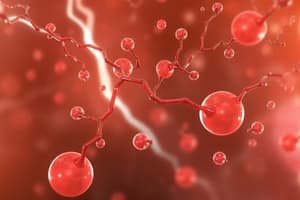Podcast
Questions and Answers
What is the main storage form for fats in the body?
What is the main storage form for fats in the body?
- Chylomicrons
- Fatty acids
- Glycerol-3-P
- Triacylglycerols (correct)
Which enzyme is responsible for mobilizing fatty acids from triacylglycerol stores?
Which enzyme is responsible for mobilizing fatty acids from triacylglycerol stores?
- FA synthase
- Acetyl-CoA carboxylase
- Hormone-dependent lipase (correct)
- β-oxidation enzyme
During which metabolic process are fatty acids degraded to acetyl-CoA?
During which metabolic process are fatty acids degraded to acetyl-CoA?
- Gluconeogenesis
- FA synthesis
- β-oxidation (correct)
- Lipogenesis
What substance serves as the substrate for fatty acid synthesis in the cytoplasm?
What substance serves as the substrate for fatty acid synthesis in the cytoplasm?
Which of the following statements is true regarding the regulation of fatty acid synthesis?
Which of the following statements is true regarding the regulation of fatty acid synthesis?
Where does fatty acid synthesis primarily take place?
Where does fatty acid synthesis primarily take place?
What is the activated donor of 2 carbon units in fatty acid synthesis?
What is the activated donor of 2 carbon units in fatty acid synthesis?
Which enzyme's reaction is the rate-limiting step in fatty acid synthesis?
Which enzyme's reaction is the rate-limiting step in fatty acid synthesis?
Which molecule provides the reducing power during fatty acid synthesis?
Which molecule provides the reducing power during fatty acid synthesis?
Which hormone acts as an allosteric activator of acetyl CoA carboxylase in a fed state?
Which hormone acts as an allosteric activator of acetyl CoA carboxylase in a fed state?
What is the final product of the fatty acid synthesis pathway as it relates to palmitate?
What is the final product of the fatty acid synthesis pathway as it relates to palmitate?
How many ATP molecules are required to form palmitate?
How many ATP molecules are required to form palmitate?
In fatty acid degradation, what molecule is primarily released as units of 2 carbons?
In fatty acid degradation, what molecule is primarily released as units of 2 carbons?
What role does malonyl CoA play during fatty acid synthesis?
What role does malonyl CoA play during fatty acid synthesis?
Where does most fatty acid synthesis occur in the body?
Where does most fatty acid synthesis occur in the body?
What effect does high cytoplasmic citrate have on fatty acid synthesis?
What effect does high cytoplasmic citrate have on fatty acid synthesis?
Which of the following hormones is associated with the inhibition of fatty acid synthesis?
Which of the following hormones is associated with the inhibition of fatty acid synthesis?
What happens to fatty acids mobilized from adipose tissue during starvation?
What happens to fatty acids mobilized from adipose tissue during starvation?
What is the primary function of acetyl-CoA produced from fatty acid oxidation?
What is the primary function of acetyl-CoA produced from fatty acid oxidation?
Which enzyme is stimulated by insulin to increase fatty acid synthesis?
Which enzyme is stimulated by insulin to increase fatty acid synthesis?
How does the enzyme system on the endoplasmic reticulum contribute to fatty acid metabolism?
How does the enzyme system on the endoplasmic reticulum contribute to fatty acid metabolism?
What is the main reason triacylglycerols have a higher energy content compared to carbohydrates?
What is the main reason triacylglycerols have a higher energy content compared to carbohydrates?
In which part of the body are most fatty acids synthesized?
In which part of the body are most fatty acids synthesized?
What substance is primarily responsible for the mobilization of fatty acids from adipose tissue?
What substance is primarily responsible for the mobilization of fatty acids from adipose tissue?
What happens to fatty acids to prepare them for oxidation in the mitochondria?
What happens to fatty acids to prepare them for oxidation in the mitochondria?
Which statement about the energy content of fats and carbohydrates is correct?
Which statement about the energy content of fats and carbohydrates is correct?
What is the role of carnitine in fatty acid metabolism?
What is the role of carnitine in fatty acid metabolism?
Which hormones are primarily responsible for activating the degradation of fatty acids?
Which hormones are primarily responsible for activating the degradation of fatty acids?
What portion of fat is considered gluconeogenic?
What portion of fat is considered gluconeogenic?
What is the result of the cleavage of 3-ketoacyl CoA by CoASH?
What is the result of the cleavage of 3-ketoacyl CoA by CoASH?
Which vitamin deficiency leads to the accumulation of methylmalonyl CoA?
Which vitamin deficiency leads to the accumulation of methylmalonyl CoA?
What is the total ATP yield from the complete oxidation of palmitate (C16)?
What is the total ATP yield from the complete oxidation of palmitate (C16)?
Which of the following reactions occurs first in the ß-oxidation pathway?
Which of the following reactions occurs first in the ß-oxidation pathway?
During which metabolic condition do ketone bodies form in the mitochondrial matrix?
During which metabolic condition do ketone bodies form in the mitochondrial matrix?
How is energy generated from the oxidation of fatty acids?
How is energy generated from the oxidation of fatty acids?
What occurs when lipolysis and ß-oxidation are elevated in the liver?
What occurs when lipolysis and ß-oxidation are elevated in the liver?
How many NADH are produced during the oxidation of each molecule of palmitate?
How many NADH are produced during the oxidation of each molecule of palmitate?
Flashcards
Fatty Acid Degradation
Fatty Acid Degradation
The breakdown of fatty acids to produce energy in the form of acetyl-CoA.
Fatty Acid Synthesis
Fatty Acid Synthesis
The creation of fatty acids from acetyl-CoA and other precursors.
Triacylglycerol
Triacylglycerol
A type of lipid made of three fatty acids bonded to a glycerol molecule; the main form of fat storage in the body.
Fatty Acid Mobilization
Fatty Acid Mobilization
Signup and view all the flashcards
Beta-oxidation
Beta-oxidation
Signup and view all the flashcards
Fatty Acid Activation
Fatty Acid Activation
Signup and view all the flashcards
Hormonal Regulation of Lipid Metabolism
Hormonal Regulation of Lipid Metabolism
Signup and view all the flashcards
Lipid Storage
Lipid Storage
Signup and view all the flashcards
ß-oxidation
ß-oxidation
Signup and view all the flashcards
Inner Mitochondrial Membrane
Inner Mitochondrial Membrane
Signup and view all the flashcards
Acetyl CoA
Acetyl CoA
Signup and view all the flashcards
Citric Acid Cycle
Citric Acid Cycle
Signup and view all the flashcards
Fatty acid degradation
Fatty acid degradation
Signup and view all the flashcards
Ketone bodies
Ketone bodies
Signup and view all the flashcards
Odd-Carbon Fatty Acids
Odd-Carbon Fatty Acids
Signup and view all the flashcards
Vitamin B12
Vitamin B12
Signup and view all the flashcards
Palmitate (C16)
Palmitate (C16)
Signup and view all the flashcards
ATP
ATP
Signup and view all the flashcards
Fatty Acid Synthesis Location
Fatty Acid Synthesis Location
Signup and view all the flashcards
Fatty Acid Degradation Location
Fatty Acid Degradation Location
Signup and view all the flashcards
Fatty Acid Synthase Structure
Fatty Acid Synthase Structure
Signup and view all the flashcards
Fatty Acid Degradation Enzymes
Fatty Acid Degradation Enzymes
Signup and view all the flashcards
Malonyl-CoA Role
Malonyl-CoA Role
Signup and view all the flashcards
Acetyl-CoA Role (Degradation)
Acetyl-CoA Role (Degradation)
Signup and view all the flashcards
NADPH in Synthesis
NADPH in Synthesis
Signup and view all the flashcards
NADH + FADH in Degradation
NADH + FADH in Degradation
Signup and view all the flashcards
Citrate's Role in Synthesis
Citrate's Role in Synthesis
Signup and view all the flashcards
Palmitoyl-CoA Inhibition
Palmitoyl-CoA Inhibition
Signup and view all the flashcards
Acetyl-CoA Carboxylase Regulation
Acetyl-CoA Carboxylase Regulation
Signup and view all the flashcards
Citrate Shuttle
Citrate Shuttle
Signup and view all the flashcards
NADPH Source
NADPH Source
Signup and view all the flashcards
Fatty acid synthesis stoichiometry
Fatty acid synthesis stoichiometry
Signup and view all the flashcards
Pentose Phosphate Pathway
Pentose Phosphate Pathway
Signup and view all the flashcards
Fatty Acid Chain Elongation
Fatty Acid Chain Elongation
Signup and view all the flashcards
Fatty Acid Desaturation
Fatty Acid Desaturation
Signup and view all the flashcards
Malonyl CoA Inhibition
Malonyl CoA Inhibition
Signup and view all the flashcards
Citrate Stimulation of Fatty Acid Synthesis
Citrate Stimulation of Fatty Acid Synthesis
Signup and view all the flashcards
Fatty Acid Synthesis Location
Fatty Acid Synthesis Location
Signup and view all the flashcards
Fatty Acid Mobilization During Starvation
Fatty Acid Mobilization During Starvation
Signup and view all the flashcards
Ketone Body Production
Ketone Body Production
Signup and view all the flashcards
Epinephrine and Glucagon Effect
Epinephrine and Glucagon Effect
Signup and view all the flashcards
Insulin Effect on Fatty Acid Synthesis
Insulin Effect on Fatty Acid Synthesis
Signup and view all the flashcards
Subcellular Compartmentalization of FA
Subcellular Compartmentalization of FA
Signup and view all the flashcards
Fatty Acid Storage
Fatty Acid Storage
Signup and view all the flashcards
Fatty Acid Mobilization
Fatty Acid Mobilization
Signup and view all the flashcards
Fatty Acid Degradation
Fatty Acid Degradation
Signup and view all the flashcards
β-oxidation
β-oxidation
Signup and view all the flashcards
Fatty Acid Synthesis
Fatty Acid Synthesis
Signup and view all the flashcards
Acetyl-CoA
Acetyl-CoA
Signup and view all the flashcards
Ketone Bodies
Ketone Bodies
Signup and view all the flashcards
Odd-chain Fatty Acids
Odd-chain Fatty Acids
Signup and view all the flashcards
Vitamin B12
Vitamin B12
Signup and view all the flashcards
Triacylglycerols (TAGs)
Triacylglycerols (TAGs)
Signup and view all the flashcards
Study Notes
Lipid Metabolism 1: Triacylglycerols and Fatty Acids
- Triacylglycerols (TAGs) are the primary storage form of lipids, more efficient than carbohydrates or proteins for energy storage
- TAGs are composed of three fatty acids and glycerol
- Fatty acids are either saturated or unsaturated
- Dietary fats are broken down to fatty acids (FAs) and repackaged as TAGs in chylomicrons
- FAs are mobilized from adipose tissue by hormone-dependent lipase (in response to glucagon and catecholamines)
- FA degradation occurs in the mitochondrial matrix via beta-oxidation
- Fatty acid synthesis occurs in the cytosol
- Entry of fatty acids into the mitochondria is a key regulatory step for degradation
- Excess acetyl-CoA from FA oxidation can be converted to ketone bodies during starvation; these are used as alternative fuels for certain tissues
- Odd-chain fatty acids are metabolized to succinyl-CoA via a vitamin B12-dependent process
- Fatty acid synthesis and degradation are regulated by subcellular compartments, tissue specialization, and hormones (phosphorylation/dephosphorylation)
Fatty Acid Degradation
- Degradation of fatty acids occurs in two-carbon units
- Beta-oxidation is the process of breaking down fatty acids in mitochondria
- Beta-oxidation pathways are similar to the last three steps of the citric acid cycle (succinate, fumarate, malate, and oxaloacetate)
- Fatty acids are degraded 2 carbons at a time, producing Acetyl-CoA as a key intermediate
Fatty Acid Synthesis
-
Fatty acid synthesis occurs in the cytosol
-
It uses malonyl-CoA as a two-carbon building block
-
It requires NADPH as a reducing agent
-
Acetyl-CoA carboxylase is the rate-limiting enzyme of fatty acid synthesis
-
Requires biotin as a cofactor
-
Regulation of acetyl-CoA carboxylase is dependent on phosphorylation/dephosphorylation
-
Allosteric activation by citrate is observed; inhibition by product palmitoyl CoA
-
Inhibition by glucagon and catecholamines
-
Phosphorylated form of enzyme shows a smaller stimulatory response to citrate.
-
Insulin (+) regulates the enzyme by promoting dephosphorylation
Fatty Acid Synthesis and Degradation Differences
- Synthesis occurs in the cytosol; degradation in the mitochondrial matrix
- Synthesis uses acyl carrier protein (ACP); degradation uses acyl-CoA
- Synthesis uses malonyl-CoA as a two-carbon unit donor; degradation releases two-carbon units as acetyl-CoA
- Synthesis uses NADPH as a reducing agent; degradation produces NADH and FADH2
Studying That Suits You
Use AI to generate personalized quizzes and flashcards to suit your learning preferences.




